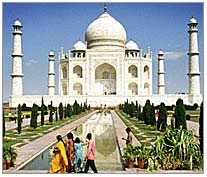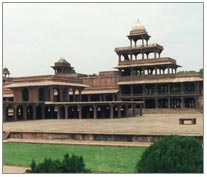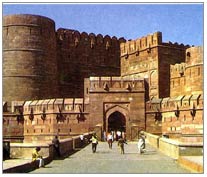RAJASTHAN TOURISM Tour Highlights Agra Tourism
Agra Tourism
Taj Mahal, Agra
Sheer poetry in marble. Majesty and magnificence, unrivalled. The Taj Mahal, the one and only one of its kind across the world. The monumental labour of love of a great ruler for his beloved queen. The ultimate realisation of Emperor Shahjahan's dream. One of the wonders of the world. From 1631 A.D., it took 22 years in the making.
An estimated 20,000 people worked to complete the enchanting mausoleum, on the banks of the Yamuna. For a breathtaking beautiful view of the Taj Mahal, see it by moonlight.
The construction of this marble masterpiece is credited to the Mughal emperor Shah Jahan who erected this mausoleum in memory of his beloved wife, Arjumand Bano Begum, popularly known as Mumtaz Mahal, who died in AH 1040 (AD 1630). Her last wish to her husband was "to build a tomb in her memory such as the world had never seen before".

Thus emperor Shah Jahan set about building this fairytale like marvel. The construction of Taj Mahal was started in AD 1632 and completed at the end of 1648 AD. For seventeen years, twenty thousand workmen are said to be employed on it daily, for their accommodation a small town, named after the deceased empress-'Mumtazabad, now known as Taj Ganj, was built adjacent to it.
Amanat Khan Shirazi was the calligrapher of Taj Mahal, his name occurs at the end of an inscription on one of the gates of the Taj. Poet Ghyasuddin had designed the verses on the tombstone, while Ismail Khan Afridi of Turkey was the dome maker. Muhammad Hanif was the superintendent of Masons.
The designer of Taj Mahal was Ustad Ahmad Lahauri. The material was brought in from all over India and central Asia and it took a fleet of 1000 elephants to transport it to the site. The central dome is 187 feet high at the centre. Red sandstone was brought from Fatehpur Sikri, Jasper from Punjab, Jade and Crystal from China, Turquoise from Tibet, Lapis Lazuli and Sapphire from Sri Lanka, Coal and Cornelian from Arabia and diamonds from Panna. In all 28 kind of rare, semi precious and precious stones were used for inlay work in the Taj Mahal. The chief building material, the white marble was brought from the quarries of Makrana, in distt. Nagaur, Rajasthan.
Fatehpur Sikri, Agra
A royal city perfectly preserved, Fatehpur Sikri provides a marvellous escape into the past. Akbar embarked on the construction of a new capital here when a prophecy of the birth of a male royal heir, by the Sufi Saint Salim Chisti of Sikri, came true.
Imposing gateways and light- hearted palaces were built in red sandstone within this fortified city only to be abandoned a few years later.

Among its many architectural game are the places for his queens - Jodha Bai, Mariyam and his Turkish sultana, built in varying styles, each perfect in itself.
The Diwan-e-Khas entirely unique in its concept is a tall vaulted room with an intricately carved central pillar and capital supporting a platform that once held the emperor's throne.
Narrow galleries link this to the corners of the room where it is believed his ministers sat The airy Panch Mahal a 5 storied structure rising in pyramidal fashion was probably used by the ladies of the court.
Set like a jewel in a courtyard of pink sandstone is the finest building here, the marble tomb of Salim Chisti enclosed by finely carved, lacy marble screens.
The Buland Darwaza, an imposing gateway 54 m high was built to commemorate Akbar's Aligarh the famous university town is a center of Islamic studies. The city is also noted for its handicrafts and metal wares.
Sikandra Fort, Agra
Welcome to Sikandra, a supurb of Agra, only 13 km. from the Agra Fort, the last resting place of the Mughal emperor Akbar. Akbar was the greatest of the Mughal emperors and one of the most secular minded royalties of his time. He was the heir to a long tradition of oriental refinement, a great patron of the arts, literature, philosophy and science.
A visit to Akbar's monument opens before one, the completeness of Akbar's personality as completely as the Taj Mahal does of Mumtaz Mahal's. Akbar's vast, beautifully carved, red-ochre sandstone tomb is set amidst a lush garden. Akbar himself planned his own tomb and selected a suitable site for it. To construct a tomb in one's lifetime was a Tartary custom which the Mughals followed religiously. Akbar's son Jahangir completed the construction of this pyramidal tomb in 1613.
Agra Fort

The construction of the Agra fort was started around 1565 when the initial structures were built by Akbar. Shah Jahan replaced most of these with his marble creations. Some however survived, among them are - Delhi Gate. Amar Singh Gate, Akbari Mahal and the Jehangir Mahal. The fort is crescent shaped, flattened on the east with a long, nearly straight wall facing the river. It has a total perimeter of 2.4 km, and is ringed by double castellated ramparts of red sandstone punctuated at regular intervals by bastions. A 9 mt. Wide and 10 mt. Deep moat surrounds the outer wall. An imposing 22 mt. High inner wall imparts a feeling of invincible defensive construction. The route through the Amar Singh Gate is dog-legged. The layout of the fort was determined by the course of the river, which in those days flowed alongside. The main axis is parallel to the river and the walls bridge out towards the city.









